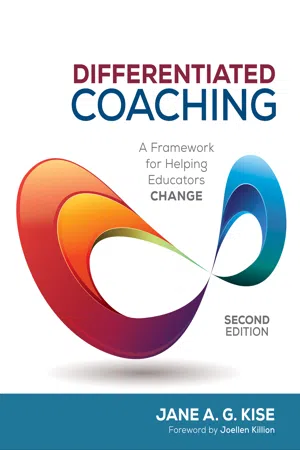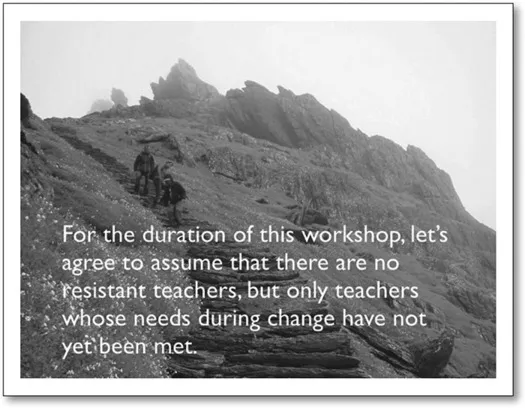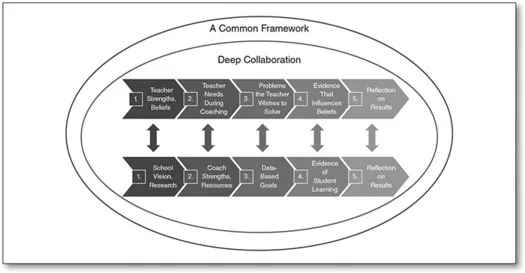
- 256 pages
- English
- ePUB (mobile friendly)
- Available on iOS & Android
eBook - ePub
About this book
Differentiate your coaching practice to meet the needs of every teacher!
Jane Kise takes you on a journey into differentiated coaching with a strength-based framework for understanding, appreciating, and working with people who may think differently from you. Through an online self-assessment tool, you will discover how your strengths and beliefs influence your coaching practice. Through examples, case studies, and reflection exercises, you will understand how to:
- Tailor your coaching practices to meet the needs of each educator
- Increase teacher willingness to implement new skills in their classrooms
- Anticipate patterns of resistance and adjust both the content and delivery of professional development
Frequently asked questions
Yes, you can cancel anytime from the Subscription tab in your account settings on the Perlego website. Your subscription will stay active until the end of your current billing period. Learn how to cancel your subscription.
At the moment all of our mobile-responsive ePub books are available to download via the app. Most of our PDFs are also available to download and we're working on making the final remaining ones downloadable now. Learn more here.
Perlego offers two plans: Essential and Complete
- Essential is ideal for learners and professionals who enjoy exploring a wide range of subjects. Access the Essential Library with 800,000+ trusted titles and best-sellers across business, personal growth, and the humanities. Includes unlimited reading time and Standard Read Aloud voice.
- Complete: Perfect for advanced learners and researchers needing full, unrestricted access. Unlock 1.4M+ books across hundreds of subjects, including academic and specialized titles. The Complete Plan also includes advanced features like Premium Read Aloud and Research Assistant.
We are an online textbook subscription service, where you can get access to an entire online library for less than the price of a single book per month. With over 1 million books across 1000+ topics, we’ve got you covered! Learn more here.
Look out for the read-aloud symbol on your next book to see if you can listen to it. The read-aloud tool reads text aloud for you, highlighting the text as it is being read. You can pause it, speed it up and slow it down. Learn more here.
Yes! You can use the Perlego app on both iOS or Android devices to read anytime, anywhere — even offline. Perfect for commutes or when you’re on the go.
Please note we cannot support devices running on iOS 13 and Android 7 or earlier. Learn more about using the app.
Please note we cannot support devices running on iOS 13 and Android 7 or earlier. Learn more about using the app.
Yes, you can access Differentiated Coaching by Jane A. G. Kise in PDF and/or ePUB format, as well as other popular books in Education & Adult Education. We have over one million books available in our catalogue for you to explore.
Information
Part I Coaching That Is Both Student Centered and Teacher Centered
What have I learned since I first wrote Differentiated Coaching?
Well, back in 2001, when I began working directly with teachers, not much had been written about instructional coaching. I’d been hired as a consultant for a school change initiative that became my doctoral research. While I had a dozen years of executive and organizational coaching experience, including school leadership, I soon realized I was immersed in a crash-course independent study on partnering with teachers during change.
The teachers and I worked on meeting the needs of more students, holding higher expectations, and differentiating instruction. The results of the change initiative and coaching? We took the failure rate on major projects at that urban middle school from over 30 percent to less than 1 percent. Overall assignment completion rates increased significantly. And of the students involved in the study, 65 percent were on track to pass the state accountability tests that year, compared with 41 percent the year before. I published the research (Kise, 2005) and the first edition of Differentiated Coaching.
As I began training other coaches, though, I realized that my unique coaching background meant that my assumptions were different than the equally valuable assumptions and mindsets that educators had toward instructional coaching. I realized I’d learned to look in two directions at once and needed to help other coaches do the same.
What do I mean? Perhaps the easiest way to explain is . . .
Imagine that you’re participating in my coaching workshop. With the administrivia out of the way, I flash up the first slide (Figure 1.1):
The person next to you chuckles, “Right, she hasn’t met our deadwood.”
But you listen as I explain my choice of image: the steep, uphill climb that changing one’s classroom often involves and the differentiated coaching techniques that build on a teacher’s strengths, needs, and concerns. And you nod as I explain my colleagues’ research. Barger and Kirby (2004) surveyed over two thousand people about what they needed during change and learned that there are clear differences in the following:
- The informational needs of people with different personalities and cognitive-processing styles in times of change
- How they process and react to that information
- What factors make change more stressful
Resistance to change increases when these needs are not met. Further, leaders, in general, fail to recognize and deal effectively with these needs.
Then, I share the story of the teacher who told me, “That new curriculum—they’re asking me to experiment on my students!” Perhaps you begin to empathize with her mounting frustration with her school district’s refusal to address her team’s concerns. And as I add in the brain research on teachers with her cognitive-processing style (p. 27), especially their aversion to taking risks, reframing teacher resistance as failing to meet their needs begins to make sense.

Figure 1.1
No doubt, though, someone behind you is muttering, “Hogwash! We need to focus on student learning, not what the teacher needs. Student-focused coaching, that’s the ticket.” But then my next slide pops up (Figure 1.2), pointing out the fallacy of believing that we either focus on teachers or on students when we need to do both.
Yes, it’s a complex graphic, but you get the point. We need to find the right rhythm between meeting teacher needs to maximize their professional growth and implementing learning community goals to maximize student learning. Combining these focuses leads to maximum change. Ignoring either one leads to problems. Now, reframing resistance makes sense.
What makes even more sense to you are the series of both/and statements that compose the differentiated coaching model. We need to look in both directions at the same time by doing the following:
- Understanding teacher strengths and beliefs and the school’s research-based vision for learning and student success
- Setting coaching cycle goals based on the problems the teacher wishes to solve and research- or data-based goals that reflect school priorities
- Meeting the needs of the teacher during change and leveraging your coaching strengths and available resources
- Collecting evidence that influences teacher beliefs and evidence of student learning
- Whenever possible, situating coaching within deep collaboration and a common language for teaching and learning

Figure 1.2 Teacher Needs and School Needs
Source: Polarity Map Copyright © 2016 Polarity Partnerships, LLC, All Rights Reserved. www.polaritypartnerships.com
Now you’re ready to dive into the practical exercises the workshop offers, designed to help you put these ideas into practice. And as I suggested, you’ve identified a teacher who, in the past, you might have labeled “resistant.” Throughout the day, you’ll be reflecting on what needs haven’t been met . . . yet.
You look again at the handout with the coaching cycle flowchart (Figure 1.3) and realize that synergy compacts the complexity!
Thoughts of the teacher you’re reframing come to mind . . . a strength . . . a legitimate question raised about a strategy . . . a concern about a school initiative . . . yes, there just might be ways to adjust your coaching.
In summary, I learned to explicitly address the difficult terrain of meeting teacher needs while concentrating on success for all students. And I use both/and thinking to suspend the idea of teacher resistance so that it is easier to assume that all teachers can meet the high expectations we have for them.
Reframing Resistance
Two things happen when we reframe teacher resistance in terms of failing to meet their needs.

Figure I.3 The Differentiated Coaching Model
- First, administrators, coaches, and professional development coordinators—anyone involved in mentoring or leading teachers—all adopt a growth mindset (Dweck, 2006), acting on the belief that all teachers can learn, given time, the right kind of support, and deliberate practice. If we want teachers to operate out of the belief that all students can learn, we need to model, in turn, that we believe all teachers can learn.
- Second, assuming that there are no resistant teachers changes how we discuss initiative implementation. A plan that starts with supporting teacher needs is very different from one that starts with, “How will we get the resisters on board?”
- And, if implementation gets a bit rocky, we focus on, “Did we choose the right goals for our staff, students, and community? Where did our planning miss the mark? How did we fail to meet the needs of the teachers? How accurate were our estimates of the time, resources, and energy needed? Did we fall into the trap of initiative fatigue?”
Meeting the needs of teachers does not mean that each of them sets their own time frame, standards, and outcomes for change. Instead, differentiated coaching incorporates research on human motivation, human differences, and adult learning, acknowledging the following:
Teachers form their practices around what they do best.Their strengths are related to their personalities and inborn cognitive processes.Their natural cognitive processes drive their educational beliefs.Changing their practices means changing those beliefs.That makes change very, very difficult.
Thus, coaching often involves communicating, questioning, supporting, and collaborating with teachers in ways that may not match what you do best—without exhausting yourself. How? That’s what this book is about.
The first half of Differentiated Coaching lays out five key elements for effectively coaching teachers for change. The second half introduces the sixth key: using a framework that helps identify patterns in teacher beliefs, needs, and cognitive processing styles that, while not eliminating the difficulty of change, adds understanding and a common language for coaching and for discussing teaching and learning.
What’s New in the Second Edition?
This second edition reflects many of the questions other coaches have asked me during the past ten years. Here’s what’s new.
- The power of and. As illustrated earlier, key elements of differentiated coaching are now stated as both/and propositions. Why? To answer the questions that either/or thinking in education reform constantly brought to the surface. Meeting teacher needs and focusing on student learning is one example.
- Reflective exercises. I’ve taken several of the exercises I developed for workshops and revised them for self-study and small-group discussion.
- Planning model. The core questions for differentiated coaching are now part of an explicit coaching cycle model you can use to reflect on potential coaching moves.
An online tool. The framework of personality type, explained in Part II, provides a powerful, neutral language for discussing teaching and learning. Through my partnership with TypeCoach, each copy of Differentiated Coaching comes with one-time access to this online, interactive tool. See page 96 for details. It isn’t an assessment but rather a process of discovery that lets you decide for yourself how you fit into the framework of personality type, a strengths-based framework for understanding, appreciating, and working with people who do and don’t think like you.
What Is TypeCoach?
TypeCoach (www.type-coach.com) is a set of web-based, interactive tools for helping people identify their four-letter personality type code and apply the concepts to work and other aspects of their lives. Designed by Rob Toomey, TypeCoach ensures that each person in an organization receives a complete and unbiased introduction to personality type and is able to verify the type that best fits their natural approach to gathering informa...
Table of contents
- Cover
- Half Title
- Title Page
- Copyright Page
- Contents
- Foreword
- Acknowledgments
- About the Author
- Acknowledgements
- Part I Coaching That Is Both Student Centered and Teacher Centered
- 1 What Do Teachers Believe?
- 2 Meeting the Needs of the Teacher During Change
- 3 What Problems Do Teachers Want to Solve?
- 4 What Evidence Will Inform This Coaching Cycle?
- 5 How Can Teachers Collaborate?
- Part II Developing a Language for Change
- 6 A Common Framework Creating a Climate Where Change Is Possible
- 7 Cognitive Processes and Coaching
- 8 Coaching Your Whole Staff for Change
- 9 Professional-Development SynergyA Final Note
- A Final Note
- Appendix A The Sixteen Types: Strengths, Beliefs, and Needs During Change
- Appendix B Problem-Solving Model
- Appendix C Polarity Thinking and Differentiated Coaching
- References
- Index
- Publisher Note